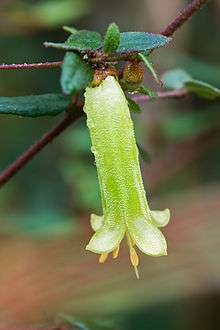Correa reflexa
| Correa reflexa | |
|---|---|
 | |
| Scientific classification | |
| Kingdom: | Plantae |
| (unranked): | Angiosperms |
| (unranked): | Eudicots |
| (unranked): | Rosids |
| Order: | Sapindales |
| Family: | Rutaceae |
| Genus: | Correa |
| Species: | C. reflexa |
| Binomial name | |
| Correa reflexa (Labill.) Vent. | |
| Synonyms[1] | |
| |


Correa reflexa, commonly known as common correa[2] or native fuchsia,[2] is a shrub which is endemic to Australia.
Description
Plants are quite variable and a large number of varieties and local forms have been identified. Heights vary from prostrate to 1.5 metres high. Leaves are generally oval in shape and range from 10mm to 50mm long. Their surfaces often have visible oil glands and short hairs.[3] The pendant, tubular flowers occur in groups of 1 to 3 and are up to 40 mm long with 4 flaring triangular tips. Colour is variable including pale green, red with yellow tips and other variations.[2][3]
Taxonomy
The species was first formally described in 1800 by botanist Jacques Labillardière in Relation du Voyage à la Recherche de la Pérouse based on the type from Adventure Bay in southern Tasmania.[4] He gave it the name Mazeutoxeron reflexum. The species was transferred to the genus Correa in 1803 by Étienne Pierre Ventenat in Jardin de la Malmaison.[4]
A number of varieties are recognised:
- C. reflexa (Labill.) Vent. var. reflexa - Raelene Goldie Correa
- C. reflexa var. angustifolia Paul G.Wilson - Grampians correa
- C. reflexa var. insularis Paul G.Wilson
- C. reflexa var. lobata Paul G.Wilson - Powelltown correa
- C. reflexa var. nummulariifolia (Hook.f.) Paul G.Wilson - roundleaf correa
- C. reflexa var. scabridula Paul G.Wilson - western correa[5]
- C. reflexa var. speciosa (Donn ex Andrews) Paul G.Wilson - eastern correa[5]
Natural hybrids have been recorded with Correa alba, C. pulchella, C. aemula and C. decumbens.[3]
Cultivation
Correa reflexa prefers a position with good drainage and some shade. The species is generally not suited to tropical regions, although use of forms from sub-tropical areas of New South Wales may afford some success.[3] Tip pruning after flowering promotes a more compact form and enhanced flowering in the following season.[6] Plants are generally pest and disease free.[3] Propagation from seed is difficult, but plants may be readily propagated from semi-mature cuttings of new seasons growth which also ensures plants are true-to-form.[3]
Cultivars
- C. reflexa 'Briagalong'
- C. reflexa 'Brisbane Range'
- C. reflexa 'Carpenter Rocks'
- C. reflexa 'Clearview Fairy'
- C. reflexa 'Clearview Large Red'
- C. reflexa 'Crystalline'
- C. reflexa 'Dawn Glow'
- C. reflexa 'Desert Glow'
- C. reflexa 'Dutchembegarra'
- C. reflexa 'Fat Fred'
- C. reflexa 'Icicle'
- C. reflexa 'Kangaroo Island'
- C. reflexa 'Lemon and Lime'
- C. reflexa 'Maroondah Tricolor'
- C. reflexa 'Mary's Choice'
- C. reflexa 'Maryborough'
- C. reflexa 'Mountain Giant'
- C. reflexa 'Clearview Giant'
- C. reflexa 'Mt Richmond Red'
- C. reflexa 'Narrow Neil'
- C. reflexa 'Old Gold'
- C. reflexa 'Portland Dawn Glow'
- C. reflexa 'Portland Peach'
- C. reflexa 'Portland'
- C. reflexa 'S.E. Gippsland'
- C. reflexa 'Squat Queen'
- C. reflexa 'Squat'
- C. reflexa 'Wildfire'
- C. reflexa 'Wilson's Promontory Lime and Gold'
- C. reflexa 'Lemon and Lime'
- C. reflexa 'Yanakie'
References
- ↑ The Plant List: A Working List of All Plant Species, retrieved 9 March 2016
- 1 2 3 Porteners, M. F.; P. H. Weston. "Correa reflexa (Labill.) Vent.". PlantNET - New South Wales Flora Online. Royal Botanic Gardens & Domain Trust, Sydney Australia. Retrieved 2 April 2012.
- 1 2 3 4 5 6 "Correa reflexa". Australian Native Plants Society (Australia). Retrieved 2 April 2012.
- 1 2 "Correa reflexa". Australian Plant Name Index (APNI), IBIS database. Centre for Plant Biodiversity Research, Australian Government, Canberra. Retrieved 2009-05-08.
- 1 2 Wild Plants of Victoria (database). Viridans Biological Databases & Department of Sustainability and Environment. 2009.
- ↑ "Correa reflexa". Australian National Botanic Gardens. Retrieved 2 April 2012.
| Wikimedia Commons has media related to Correa reflexa. |